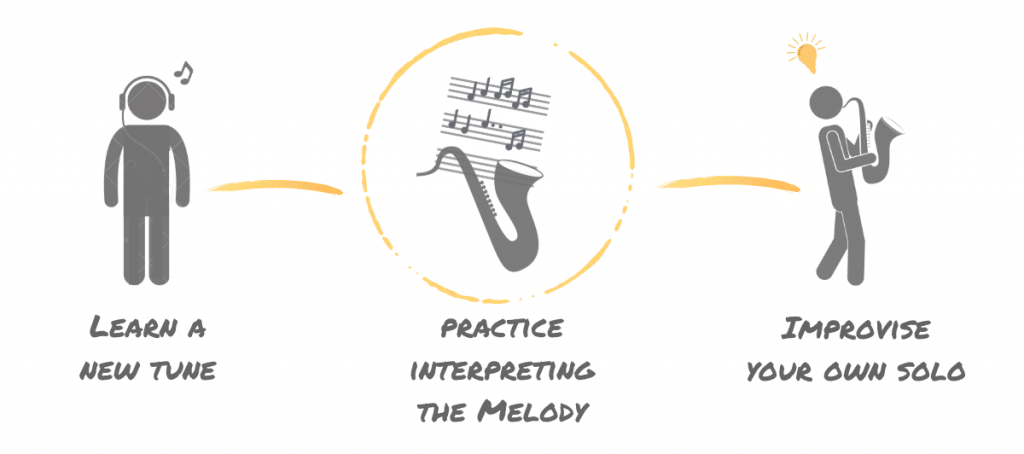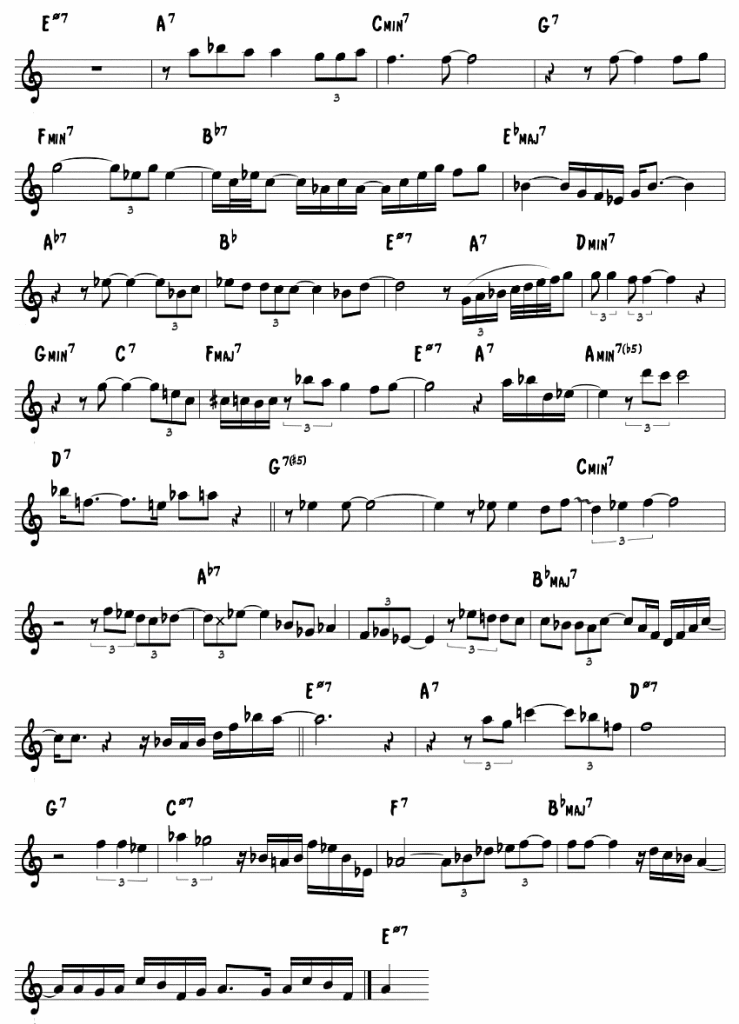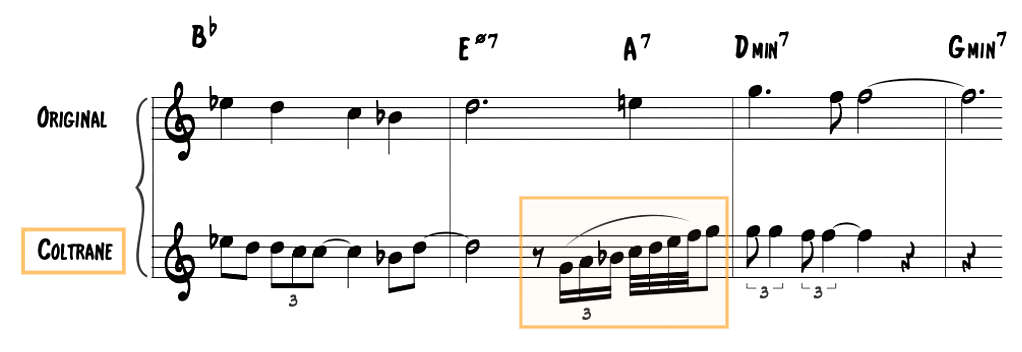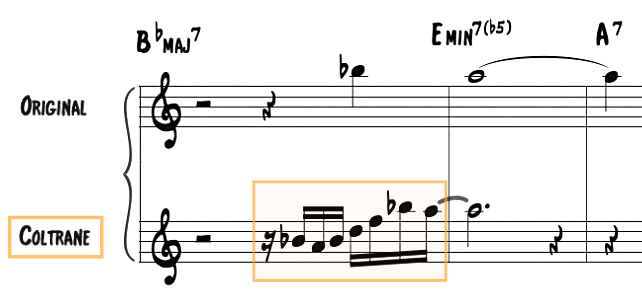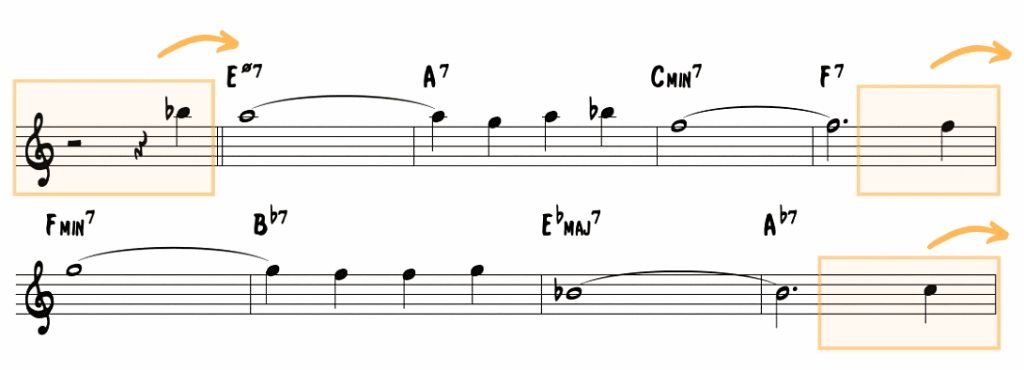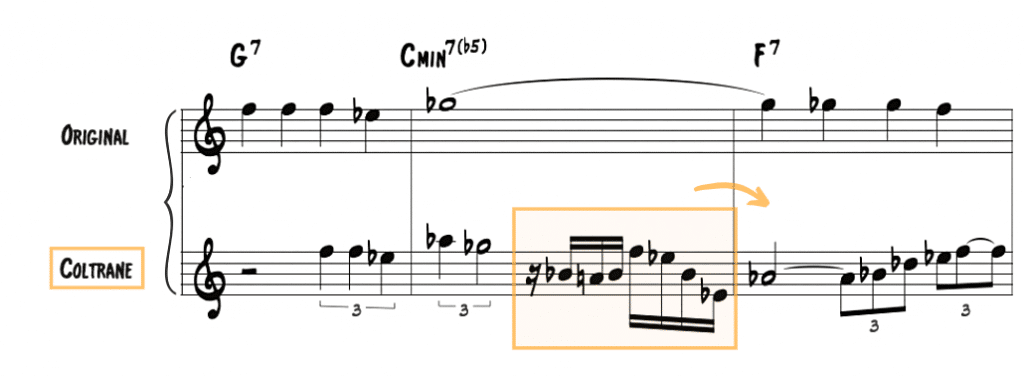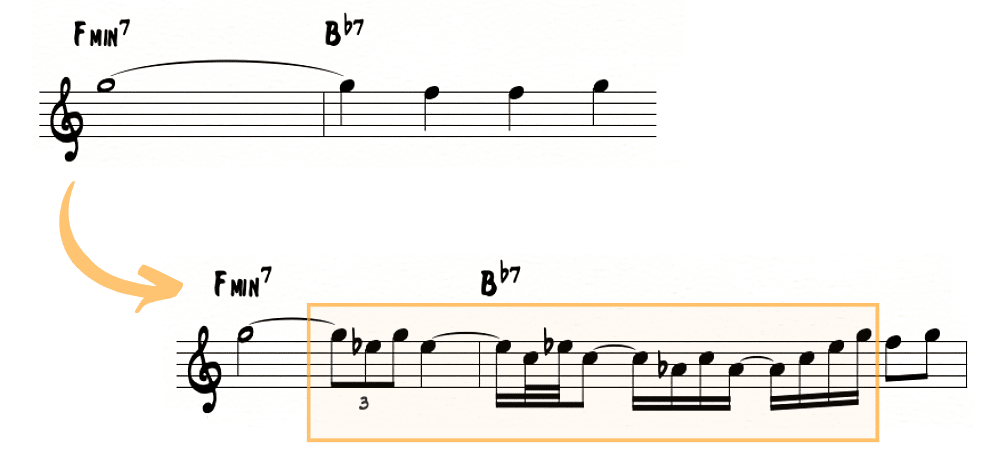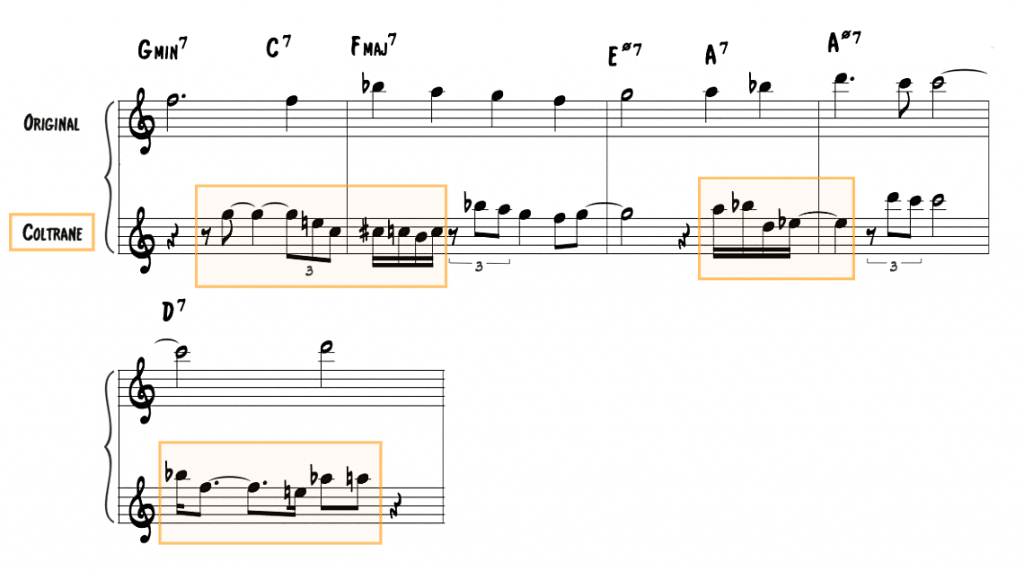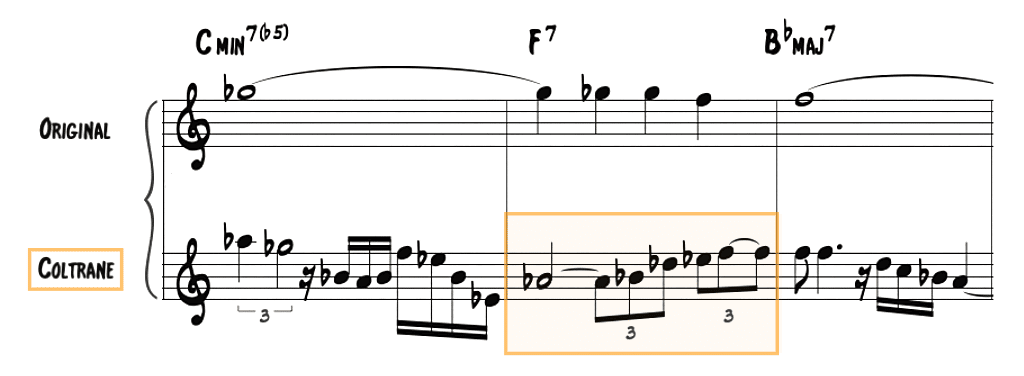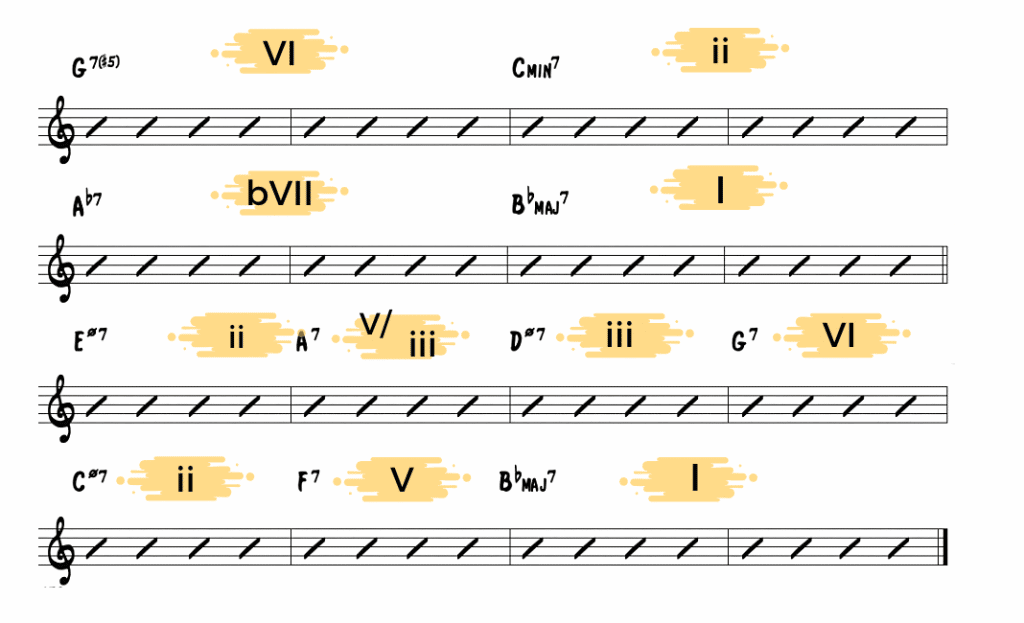One of the most frustrating things about learning to improvise is the expectation that you can simply jump in and start creating a great solo right away…
The belief that you can learn a single scale and sound good over Major chords. Or that you can study a few theory rules and suddenly improvise effortlessly over a chord progression.
But the place where many players feel this frustration the most is when it comes to learning and improvising over tunes…
There’s an unconscious expectation among musicians and educators that you can approach the jazz repertoire simply by memorizing the chords and melodies from a lead sheet. That with a few run throughs, you’ll be able to start creating a logical and musical solo right away.
Like many players, I believed this for a long time. I’d memorize tunes from the real book before rehearsals and gigs, then try to improvise over a blank chord progression, hoping that something would just “click” along the way.
But that never happened…
In solo after solo I scrambled to pick the right scale and wondered how to connect the chords. The barrier to the musical breakthrough I was looking for came down to one thing – I was ignoring the importance of the melody!
If you think about it, making melody is the main goal of improvisation…but the ironic thing is we never devote specific attention to studying it or interpreting it.
Improvising isn’t just about choosing the right notes or scales to play at the right time, it’s about crafting musical phrases and creating an emotional effect with your sound and time.
…and this takes a specific type of practice!
Why You Need to Focus on the Melody
Improving the musicality of your solos requires a shift in the way you’re approaching the melodic content of the jazz repertoire…
Rather than something to be hastily memorized and tossed out, studying and working on a great melody can teach you about phrasing, shape, tension & resolution, and crafting ideas.
…it’s also the perfect template for creating your own solo over the chord progressions of the jazz repertoire.
Great musicians in any genre are masters at interpreting and expressing melody, whether it’s improvised or composed. The ability to take an existing melodic line and make it your own is essential.
And like any other musical skill, this ability is something that doesn’t just happen by chance – it’s a skill that you need to devote time to in the practice room.
This is something many players forget when it comes to learning and playing tunes. Simply memorizing the melody & chords and winging it is not going to cut it if you want to play like your heroes.
Remember, you have a blueprint staring you in the face every time you learn a tune…the melody!
The missing step in effectively learning jazz standards
The crucial step that most players forget is taking the time to study and interpret the melody before improvising a solo…
Rather than the endless routine of memorizing tunes and struggling to improvise original lines, you should follow these 3 steps with any tune you want to learn:
- Learn it – listen, memorize, and ingrain it.
- Interpret the melody – study the chord tones & phrasing, then improvise within this framework – vary rhythm, note choices, etc.
- Create your own solo
When you finally have the melodic framework ingrained, you’ll be much more successful at developing a musical solo that follows the structure of the tune.
That’s why this step of interpreting the melody – studying the original line, adapting it, and improvising with it – is crucial in understanding the chord relationships and how to craft your own solo.
Improvising isn’t just about making stuff up out of thin air, it’s about being creative within the framework of each tune you learn. This is why you need to improvise with the original melody!
And in today’s lesson we’re going to look at how a musical master does exactly that…
Transcription: John Coltrane Stella By Starlight
To see the power of melody in crafting a solo over a progression, let’s check out John Coltrane’s interpretation of Stella by Starlight from the album 1958 Miles.
On this track, instead of solos in the traditional sense, each player takes a “solo” chorus interpreting the melody…
Coltrane’s solo starts at [1:45] in the recording, listen to the excerpt and check out the transcription below:
With a few simple techniques, Coltrane takes the melody to Stella by Starlight and turns it into a musical statement with personality, harmonic complexity, and rhythmic interest…
Essentially making his own musical statement using the framework of an existing melody. And this is something you can do in every tune that you play!
5 Melodic Interpretation Tactics
At first glance, this transcription of John Coltrane’s chorus on Stella looks complex, like lines improvised from scratch over a chord progression.
But upon closer inspection, you’ll see (and hear) that he is sticking to the framework of the melody. Take a listen to the original to see what I mean…
Now take a look at the opening to Coltrane’s interpretation. If you zoom out and look at the big picture, he is sticking to the original, being creative while still retaining the melodic notes and overall phrases:
You can create personal and creative phrases within the framework of the melody – and it’s precisely this step that’ll get you to creating your own melodic phrases.
The notes & phrases of the melody are the road map for navigating the harmonic structure of the tune. And a starting place for creating your own solos…
Let’s take a look at 5 specific tactics Coltrane uses in this solo to interpret the melody of Stella by Starlight. In the musical examples below, we’ll show you an excerpt of the original melody along with Coltrane’s interpretation…
1) Rhythmic variation and phrasing
One of the simplest ways to interpret a melodic line is to get creative with the rhythm and phrasing.
Coltrane does this in two ways. First with the actual rhythmic content of the notes he plays and secondly, with the way he is phrasing or placing his phrases within the progression.
Check out the way he opens his solo…
Here Coltrane delays his entrance and compresses the first four bar phrase into two bars:
Taking the same melodic material from the original line and compressing it, while also varying the rhythmic content.
Another simple example of this technique can be found a few bars later on the bridge. Here Coltrane simply alters the rhythm of the sustained Eb and F…
And again, at the end of this example he compress the last measure into two beats. Both simple, yet effective techniques in taking a written melody and making it more expressive.
Here are some other rhythmic devices and phrasing ideas that you can employ:
- Start phrases on up beats vs. downbeats
- Delay the start of the phrase or the delay resolution of a line
- Alter the rhythmic content, extend notes, or shorten notes
- Use triplets, 16ths, play across bar lines, etc.
As we cover other melodic techniques below, notice how Coltrane utilizes these rhythmic ideas in creative ways in each line…
2) Emphasizing goal notes & phrases with melodic motion
Along with incorporating rhythmic variation within the melodic framework, Coltrane creates melodic motion at key points to highlight a goal note or the start of a phrase
This is a great way to add style to your solo, creating momentum into a new line or to emphasize a goal note. Check out this example…
Here he is aiming for the G on the D-7 chord, useing a scalar fragment to emphasize the melody note, adding more melodic interest than a simple quarter note E would.
He uses this technique once more leading into the last 8 bars of the melody as well. Instead of simply playing the pick-up Bb to the last phrase, he plays a BbMaj7 arpeggio:
He combines the tactics of rhythmic alteration and outlining the underlying harmony to start the phrase with motion.
As you approach the tunes you’re learning, find those key melodic and harmonic points where you can incorporate melodic motion. For instance, you might take the original melody and isolate the points where each melodic phrase begins:
Along with identifying the beginnings of phrases, you can also look for key harmonic points in the tune where you can emphasize specific goal notes.
For instance, look at how Coltrane utilizes a melodic run to land on the Ab over the F7 chord below:
Once you identify a goal note, try to create melodic momentum using the underlying harmony that leads into this note.
3) Embellishing longer notes
Another simple way that Coltrane interprets the melody, and a great place for you to start in the practice room, is embellishing the static and sustained notes in the phrases.
In other words, sticking to the melodic framework while inserting your own musical ideas at opportune moments in the melody. To see what I mean, check out the line below:
Here Coltrane uses simple techniques with a big musical effect: arpeggios and simple pieces of language.
Instead of holding a static G over the F-7 chord, Coltrane inserts a descending F minor arpeggio, from the 9th to the 3rd of the chord:
And because it’s a ii-V7 progression where both chords are related, the same harmonic/melodic material can be applied to both the F- and Bb7 chords.
Along with arpeggiating the underlying chord, another technique Coltrane uses to interpret the longer static melodic notes is inserting pieces of language.
On the Eb Maj7 chord at the end of the phrase he uses a simple piece of Major language to add interest to the line:
Let’s take a look at another example from Coltrane’s solo that utilizes both of these techniques:
Instead of sustaining the half note D’s, he utilizes the chord tones of Ab7 paired with diatonic material to add melodic interest. He also ends the line arpeggiating a Bb Maj7 chord rather than sustaing the 9th.
Finally take a look at the way Coltrane ends his solo, again using Bb Major language in place of a sustained or static note…
This tactic requires having language and melodic techniques for approaching the basic chords in any tune. Check out our course Melodic Power to quickly build these essential skills!
4) Altering notes in key places
One of the best places to add alterations into a melodic line or a chord progression are on the dominant 7 chords…
Highlighting different notes on the V7 chords to create varying levels of harmonic tension and accentuate resolutions. (Check out this lesson for more on V7 alterations!)
Let’s look at out how Coltrane applies this concept to the melody of Stella, starting with the line below:
He emphasizes the #9 (C) and b13 (F) on the A7 chord, which resolves to the F on the D-7b5 chord. The original melody highlights the b9 (Bb), but Coltrane opts for the color of the #9.
In the phrase below, Coltrane emphasizes alterations on three dominant chords…
Here he delays the resolution of the C7 chord, emphasizing the b9 (C#). On the A7 he anticipates the upcoming AØ7 chord with the Eb, and over the D7 chord he emphasizing the b13, #9, and b5.
All of these note choices create tension on the V7 before resolving to the next chord. Here’s one more example from this solo…
On the F7 chord, Coltrane chooses to highlight the #9 (Ab) before resolving to the I chord. He’s still operating within the overall melodic framework, just shifting the harmonic color and tension with his note choices.
5) Chord function & how it relates to melody
It’s important to remember that the chords in a tune don’t exist in a vacuum…
They are related to each other and have a purpose within the larger progression. Understanding this is key to interpreting the melody effectively and eventually improvising your own solo.
If you understand the function of the progression you can adapt the melody notes to fit into this harmonic framework, using your own techniques and language as ornamentation.
For example, you might include your own:
- ii-V-I lines and techniques
- V7 concepts
- Turnarounds
- Other techniques for common chord progressions
It’s also important to study how the melody notes navigate this progression, which chord tones are used, which are resolved or sustained, etc.
For instance, take the last 16 bars of Stella and think about the function of each chord as it relates to the key of Bb…
Understanding chord function will show you the harmonic direction of the tune, and the melody will show you how to navigate it in a melodic way – which chord tones to use, phrasing approaches, and language to apply.
Remember, you can’t just blindly add in alterations, embellishment, and melodic runs into an existing melody. All of the techniques we covered above hinge on this underlying chord relationship.
…and this is something that Coltrane understood on a deep level!
Now choose a tune to learn…
With these 5 tactics for interpreting melody down, it’s time to choose a jazz standard to learn…or even tune that you’ve played before, but have trouble improvising over.
Instead of blindly trying to solo over the chord progression, simply start with the written melody!
Having a long list of memorized tunes doesn’t mean much if you can’t improvise over them in a musical way. Start on the right foot with ONE tune!
After you’ve memorized the melody and chord progression, it’s time to interpret the melody in your own way. Limit yourself to this framework, challenge yourself to be creative with these notes and phrases…
- Start with the rhythm and phrasing
- Incorporate melodic motion at the start of a phrase or moving toward certain goal notes you’d like to emphasize
- Embellish sustained notes with language or the chord tones of the underlying harmony
- Alter notes of the melody, particularly on the V7 chords
- Add in small improvised ideas within the melodic framework based on the chord relationships in the tune
All of this will help you to understand the tune on a deeper level and will naturally improve your own approach to the tune.
This is a great exercise to do with a tune like Cherokee, with simple melodies and sustained notes. In fact, it’s something that you should be doing with every tune you learn.
After a learning and practicing a few tunes in this manner, you’ll find yourself with a more in-depth understanding of each tune…and best of all, playing melodic lines that finally make sense!


